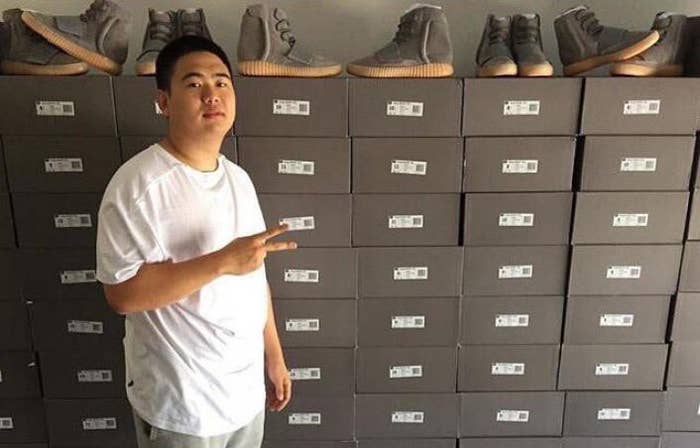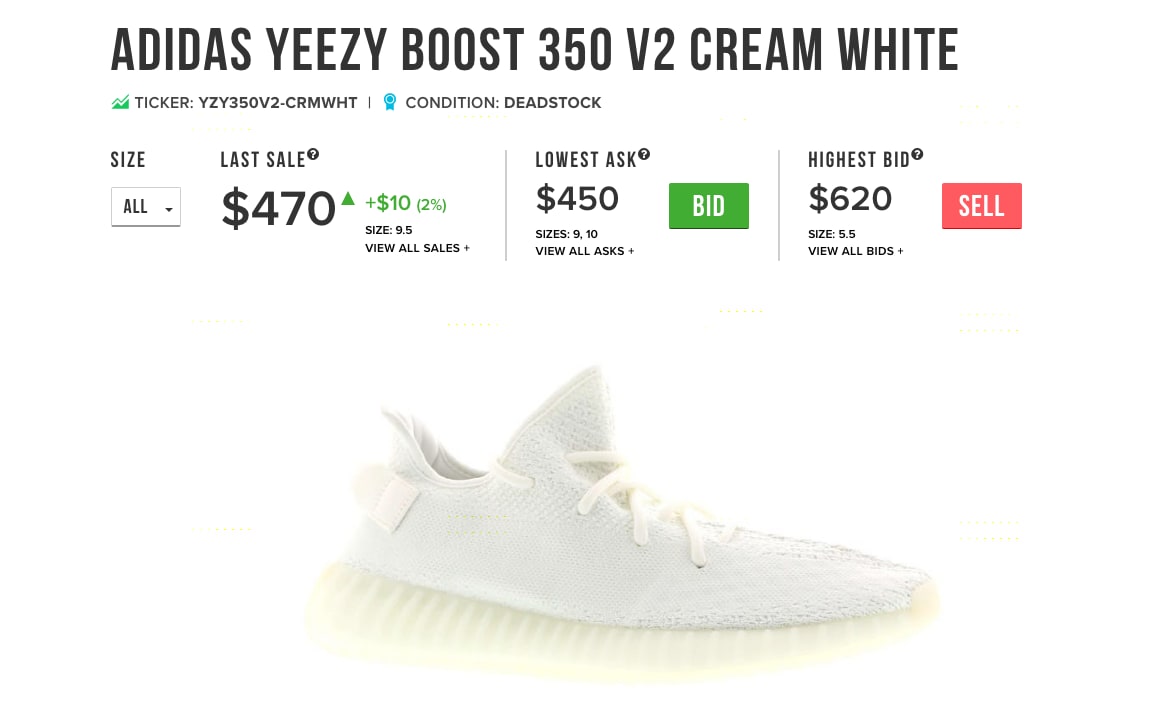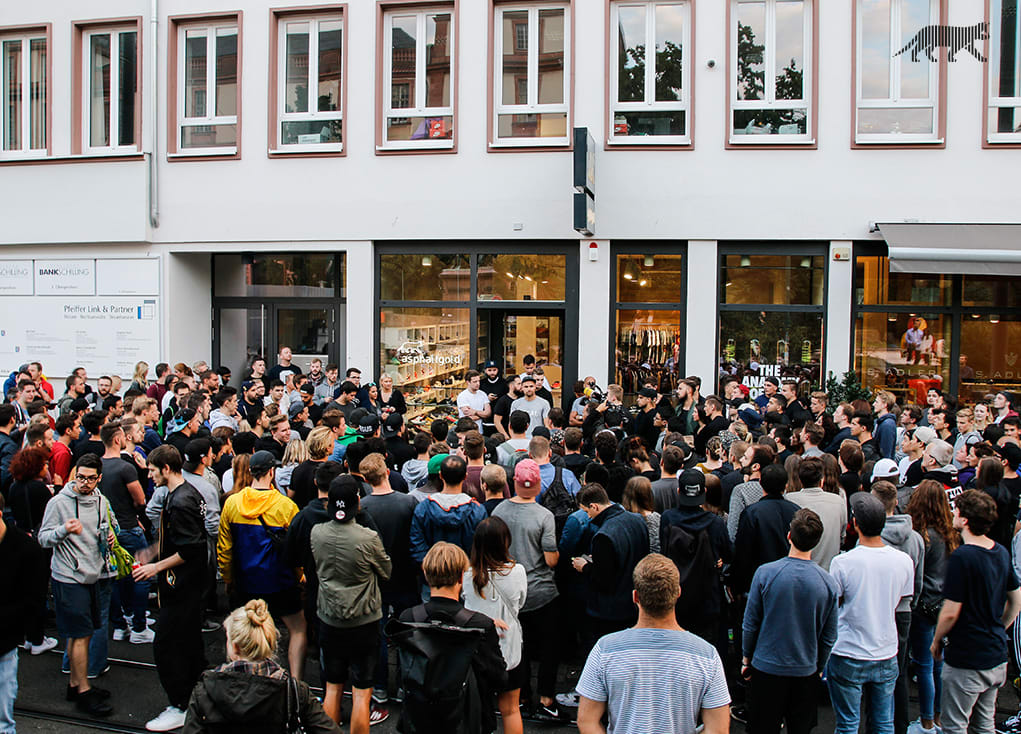
Sneaker reselling has become a billion-dollar industry, according to Josh Luber, the 39-year-old of StockX, a footwear stock market that allows buyers and sellers to do business at a fair market value. And it shows no signs of slowing down. Every hyped sneaker release -- whether it’s the latest Yeezy, limited-edition Air Jordan, or Ronnie Fieg collaboration -- one thing’s for certain: People are going to buy the shoes with the sole intent of reselling them. What’s changed, however, is how people sell them. It used to be commonplace that people who were selling sneakers on the secondary were simply unloading their collections or pushing a one-off pair that rocketed in value. Now, literally every sneaker that releases is being resold by the bundles. And it’s easier than ever, thanks to consignment shops like Flight Club and Stadium Goods, apps such as StockX and GOAT, and social media platforms, particularly Instagram and Facebook. Sneaker reselling has been normalized, and that’s forced the practice to evolve into something many never saw coming a decade ago.
Many more people are reselling shoes, partly due to the fact that sneakers have become a lot more mainstream than they were 10 to 15 years ago. Moms are entering Yeezy raffles and kids under the age of 10 are trying to flip shoes that they bought on the weekend. That’s drastically different from the early days of reselling, when there was a lot more legwork involved, and it wasn’t a full-time hustle for as many people.
“It’s growing, because it’s easier to resell shoes. When I think about resellers back in the day when I started 10 years ago, there were two types: the eBay guy and the message-board guy,” says Jason Faustino, the 33-year-old co-owner of New York sneaker boutique Extra Butter, who doesn’t resell shoes himself, but deals with resellers on a daily basis at his shop. “For the message board guy, it was so much work. They got a pair and they dabbled in it. If they can get access to a pair, they’d put in the work and push it out through NikeTalk or Sole Collector. Nowadays it’s so easy, because you can get the pair and you know what it’s worth. There are so many channels, whether it’s eBay or Stadium Goods. You can use your Instagram and look up hashtags and get off the shoe they need to sell.”
The boom in sneaker reselling has turned former shoe hustlers into business owners who do it as a full-time career. Some who used to sell sneakers out the back of their trunk have abandoned this venture to open up their own consignment shops. “From 2010 to 2012, I was selling a lot of shoes out of my car, just getting releases that people wanted, because I had the connection to get those shoes,” says 34-year-old Adam Gage, who’s more commonly known in the sneakerhead community as “Soley Ghost” and is the owner of East Coast Boutique, a sneaker consignment shop in Edison, New Jersey. “I used to sell sneakers that I previously owned that I had extras of. I used to sell the Lifestyle Air Jordan releases around 2006. I was buying two or three pairs at a time. I had one pair that I would wear, one that I would keep in my closet, and then another I’d sell just to get back more money. Nowadays nobody cares about having the shoe for themselves, they only look at it as a monetary value.”
The transformation of reselling from part-time side hustle to full-time career has changed Gage’s business model from to top to bottom—he isn’t driving from customer to customer and selling them one or two pairs of shoes anymore. “The problem with hustling sneakers is that you have to go meet people and you hear all these stories about people getting killed over shoes. Having a central location where people come to you is easier,” Gage says. “You also have your inventory on hand at all times. When you’re meeting people to sell sneakers, you might just have one or two pairs of sneakers on you. If they come to your store, one sneaker purchase could turn into 15.”
Fear of violence in hand-to-hand meetups is very real, as Gage knows from first-hand experience. His business partner, Jamaal “Mally” Gaines, was killed after hours at East Coast Boutique’s now closed Rahway, New Jersey, location over a dispute. The story made national headlines and made people think twice about the fear that’s associated with selling sneakers.
“I would advise people that if they’re going to sell these shoes, meet up in public places or outside of police stations,” Gage says. “People are getting shot over simple GRs. I feel bad for people who put their life at risk to make $40 or $50. It’s scary. It’s not like it was back in the day. Nowadays people will rob you over a $150 sneaker.”
The threat of being robbed has prompted many people to move from reselling in person to using apps or consignment shops. “I’d much rather spend $10 bucks and ship it, rather than spend hours and meet someone in a parking lot and deal with danger,” says Luber.
Luber went from working at IBM to launching a website called Campless that treated the sneaker industry like a stock market and tracked the resale value of shoes like a portfolio. This lead to him launching StockX with Cleveland Cavaliers owner Dan Gilbert in 2016. The site has gone from a place where prospective buyers and sellers can find the market value of sneakers to a reselling platform itself, eliminating the need to sell sneakers in the flesh for many. It’s also helping normalize a fair price for hyped shoes, which often fluctuate wildly on marketplaces such as eBay.

“The big difference between eBay and Stock is if you go to eBay and search for a pair of shoes, you’ll get a ton of different results. But if you go to the stock exchange and search for ‘Apple stock,’ there’s one ticker symbol for that. It’s the same with StockX. Instead of going through a thousand listings on eBay, we put it all in one place and make it easy to get to the true market price,” he says. “It normalizes sales, and it’s less hit or miss of what you’re gonna get. You’re not gonna get screwed by someone selling their sneakers for different prices. In the beginning, the sellers were the ones who benefited the most from eBay—they could get more because they had a higher rating. But with StockX, it becomes more efficient over time and gets rid of the hit-or-miss parts of eBay.”
As the reselling industry has grown, sellers and owners of consignment stores, which typically take a 20 percent profit from each sale, have become more savvy in how they operate. They’re learning how to sell sneakers faster and at a more efficient rate. “I make my prices at or below what they’re at online,” Gage says. “Take the ‘Wings’ Air Jordan XIIs. When they came out, there were 12,000 pairs and they were going for $1,000. Now they’re at $600-$700. I sell my pairs between for $500-$600. The same thing is happening with the ‘Wings’ Air Jordan 1s. I tell them, ‘You have about a week or two to get rid of that shoe. If you think you’re going to hold onto that shoe for 15 months and get $1,000 for that shoe, it’s never going to happen.”
Gage says apps, consignment stores and mass resellers are making things harder for smaller resellers, who buy a shoe to flip it, make a little money, and then buy the next one. It’s easier to resell sneakers, so more people are doing it—which means that prices have gone down. . “It’s become easier to buy shoes, but, as a reseller, it’s become harder to sell them, because there are so many avenues now. You have the GOAT app, StockX, and all these other people who caught onto this whole resale thing,” he says. “It’s made it more widespread for these ‘sneaker hustlers.’ They don’t own anything. It’s like selling an ounce of weed, except you’re selling a pair of sneakers.”
The resale market shows no signs of slowing down, and the biggest name in the game, Flight Club, believes its growth is correlated to booming of sneaker “culture.” Our platform is home to a full spectrum of sellers, from one-offs to full size runs and everyone in between. We’ve seen continual growth over the years as a direct result of the rise of sneaker culture’s popularity,” says Flight Club’s Head of Consignment, Steven Luna. “With the frequency and quantities in which sneakers release these days, the market is possibly the most kinetic it’s ever been. This is good news for us and the industry in general.”
Faustino estimates that 25 percent of the average release at his store will be purchased by resellers. “I don’t see hand-to-hand reselling as much as we used to, but if we sold Yeezys first-come, first-served, then we’d see reselling right outside the door,” he says. “If something’s happening, it’s not happening right then and there. Maybe they’re quieter about it and meeting around the corner. When a product drops, it moves fastest right away, and then they want to move on to the next thing.”
The percentage of resellers could change due to the scarcity of the release, too. There’s a misconception that resellers only go after the most-hyped sneakers, but, in reality, a lot of them find find it more efficient to gobble up lesser-known releases and sell more of the shoes at a smaller profit, rather than waiting eight hours to get one pair of sneakers. “Say we have an NMD that’s in-store on a Thursday, the resale number is higher. It might be 65 to 70 percent, judging by the way they purchase and what happens afterwards. It could be one guy and they send a bunch of kids to get the shoes, because they’ve been paid by one person,” Faustino says.

That’s just one retailer, however, with two locations in New York. The larger landscape of resellers gets murky, as it’s not an exact science, but Luber has data from industry research firms to back up his estimation of how many people are buying sneakers simply to profit. “[A couple years ago] about four percent of Jordans ended up on ebay. EBay was a quarter of the resale market [at the time]. 15 to 20 percent of all Jordans, at the time, were being resold. A lot of Jordans sit on shelves now, so maybe those numbers have changed a bit. I’m guessing that number is higher for Yeezys. Now Jordans are about at 10 percent.”
Luber goes on to say that Adidas has gone from one percent to nearly a third of the sneaker resale market, partly thanks to Jordan Brand flooding the market with more shoes in higher numbers, but also Adidas’ growth thanks to Kanye West and popular models such as the Ultra Boost and NMD. This is huge, because Jordans were once the jewel of the reselling market, and many can claim that they birthed the whole thing. But Jordan Brand has started to make more and more pairs and colorways every year, while raising the prices on the shoes, too. It’s cut out the reseller on many of the company’s releases, and the hype has shifted over to Adidas for the time being. With Adidas slowly producing higher quantities for each successive release, the brand could face the same fate as Jordan Brand, or at least some think so.
Every Adidas Yeezy release has drummed up massive hype, but it’s also starting to plummet as more pairs are made and more people are buying them just resell and cash in. “It all comes down to supply and demand. They’re making more shoes than people who want them. Like with the most recent ‘Cream White’ Yeezys, I bought 75-80 pairs. On the first day I sold 10 pairs. With the previous Yeezy releases, we were selling them as fast as they were coming in,” Gage says. “I think they put 40,000 pairs of them on Adidas.com. There aren’t as many people who are trying to buy the sneakers from resellers as the amount of pairs that they’re making. You see it with Air Jordans, and that’s why they’re sitting on shelves.”
Resellers, whether people like to admit it or not, are the ones that are moving the needle within sneaker “culture,” and their campouts, buying out stores, and high prices create a buzz around sneakers that’s undeniable, and this isn’t lost on the retailers, either. “I don’t like to incite drama or nonsense to a sneaker release, but resellers bring a lot of energy. I love the commitment to the culture, that they’re so on top of it. They’ll do the work it takes to get their pair,” Faustino says. “Some other guy who’s catching the hype of Supreme or a Yeezy wave, they don’t want to put in the work. The reseller’s going to put in the work, maybe because he has a different endgame. But it brings energy to the culture and releases. Even the guys who aren’t that into it, they now need to figure out ways to beat the resellers. People would rather buy firsthand than from a reseller.”
The resale prices are something that consumers are learning to deal with, whether they like it or not. Nearly every coveted shoe will be sold for more than its sticker price in a matter of hours after it’s sold out. If people want the shoes, they’ll have to find a way to get them or fork over the extra dough. “People think if they won a raffle or got something at retail, it’s like they got a discount,” Faustino says.
This sentiment is echoed by the people who are behind the formats that bring reselling to the forefront. “As a consumer, I made peace with it a long time ago that just because a shoe retails for $190, that’s not the market price of the shoe,” Luber says. “Even resellers, who are professional resellers, are putting time and money into shoes. Even the kid who camps outside of Foot Locker for eight hours to get a shoe. Am I going to do that? No, because I value my time as money and the premium to owning that shoe is a trade off.”
The story of sneaker resellers has gone from connoisseurs who were selling old shoes or helping fellow collectors out to everyone who could get their hands on a pair of sneakers taking advantage of the system. Money talks, often more e than owning a cool pair of shoes. “I’ve seen someone get a pair of sneakers that they waited on in their size and someone was waiting outside with cash saying, ‘I want these right now,’” Faustino says. “I don’t think the person who got the sneakers was even looking to sell them, it’s just that opportunity was there and they go for it.”
As long as people are willing to pay extra money for sneakers -- and it becomes a regular occurrence -- there are going to be people there to profit off of it. It’s basic economics, and it’s not going away as long as people want the latest and greatest sneakers.

